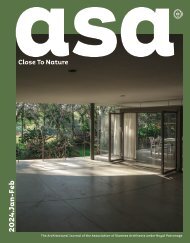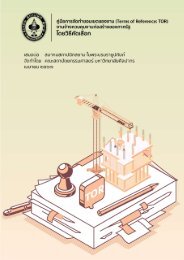ASA JOURNAL 11/2023
Create successful ePaper yourself
Turn your PDF publications into a flip-book with our unique Google optimized e-Paper software.
38<br />
around<br />
ARCHITECTURE ASIA FORUM SERIES<br />
39<br />
23-24<br />
ช่วงปิดท้ายของ Forum<br />
เป็นการแลกเปลี่ยนความ<br />
คิดเห็นของสถาปนิกไทย<br />
ร่วมกับนักวิชาการและ<br />
สถาปนิกนานาชาติ<br />
23<br />
ในช่วงปิดท้ายของ Architecture Asia Forum Series:<br />
Thailand Contemporary Architecture ด้วยการเสวนา<br />
ร่วมกันระหว่างนักวิชาการและสถาปนิกนานาชาติ ได้แก่<br />
Professor Nilda Valentin, Associate Professor Veronica<br />
Ng, Nuno Soares, Zhu Xiaofeng, Professor Wu Jiang,<br />
Associate Professor Zhou Minghao และ Assistant<br />
Professor Wang Yanze เกิดข้อสังเกตจากการบรรยายของ<br />
สถาปนิกไทยทั้ง 10 กลุ่ม ทั้งความคิดเห็นอื่นๆ เกี่ยวกับ<br />
สถาปัตยกรรมไทยร่วมสมัยจากมุมมองต่างๆ และการ<br />
ทำางานของสถาปนิกไทยที่เป็นประโยชน์ต่อวิชาชีพสถา-<br />
ปัตยกรรมทั่วโลกในหลากหลายประเด็นที่น่าสนใจ เช่น<br />
การทดลองเกี่ยวกับวัสดุและการก่อสร้าง การแสดงออกถึง<br />
จิตวิญญาณสถานที่ (Genius Loci) และภูมิภาคนิยมเชิง<br />
วิพากษ์ (Critical Regionalism) นวัตกรรมวัสดุที่ช่วยสร้าง<br />
ความยั่งยืนให้กับสถาปัตยกรรมประเพณี ความสัมพันธ์<br />
4 มุมระหว่าง Global-Local และ Urban-Rural ทางเลือก<br />
ของการใช้วัสดุและเทคนิคการก่อสร้างอื่นๆ นอกจากโครง-<br />
สร้างเหล็กและคอนกรีต การตอบรับกับบริบทและโปรแกรม<br />
ในรูปแบบเฉพาะตัว การคำานึงถึงภูมิอากาศและประเด็นทาง<br />
เศรษฐกิจ การให้ความสำาคัญกับสภาพแวดล้อมธรรมชาติ<br />
การสร้างความยั่งยืนผ่านสถาปัตยกรรม การเคารพบริบท<br />
ที่มีอยู่เดิม และการผสมผสานของเก่ากับของใหม่ เป็นต้น<br />
With the Singapore International School of Bangkok<br />
Thonburi Campus Phase II, Plan Architect created<br />
the architecture by blending natural materials into<br />
the building’s interior functional spaces to combat<br />
air pollution. The building’s gradually deviated shape<br />
welcomes the open space inside the project and promotes<br />
physical and visual continuity with the existing<br />
buildings. The smaller structures are connected by<br />
a network of semi-outdoor walkways, and the public<br />
areas are covered by a roof structure with ascending<br />
and descending sections. The majority of the time,<br />
the space is left as an open-air area, but on days with<br />
significant concentrations of PM 2.5 smog, the windows<br />
can be shut, and industrial fans can be brought<br />
in to create a positive pressure space.<br />
Architecture Asia Forum Series: Thailand Contemporary<br />
Architecture concluded with a panel discussion<br />
featuring international academics and architects, including<br />
Professor Nilda Valentin, Associate Professor<br />
Veronica Ng, Nuno Soares, Zhu Xiaofeng, Professor<br />
Wu Jiang, Associate Professor Zhou Minghao, and<br />
Assistant Professor Wang Yanze. The presentations<br />
of the ten architecture firms elicited many insightful<br />
observations, ideas, and perspectives on contemporary<br />
architecture. There are a number of intriguing<br />
issues regarding the practice of Thai architects and<br />
their contributions to the global architectural profession,<br />
ranging from experiments on materials and<br />
construction, the expression genius loci (prevailing<br />
spirit or atmosphere of a place), critical regionalism,<br />
material innovations that provide greater sustainability<br />
for traditional architecture, the four-way relationship<br />
between Global-Local and Urban-Rural, and the use<br />
of alternative materials and construction technology,<br />
to the use of alternative materials and construction<br />
techniques in addition to steel and concrete structures.<br />
Then there are other discussions revolving around<br />
context and program-specific designs, with a consideration<br />
in local climate, economic landscape, and<br />
environment, to how sustainability can be achieved<br />
through architecture, to a design’s respect for the<br />
preexisting context as well as possible integrations<br />
and interactions between the old and the new.<br />
24<br />
ผศ.ดร.สายทิวา รามสูต<br />
เป็ นอาจารย์ประจำาภาค<br />
วิชาสถาปั ตยกรรม คณะ<br />
สถาปัตยกรรมศาสตร์<br />
มหาวิทยาลัยเกษตรศาสตร์<br />
มีความสนใจในการอยู่ร่วม<br />
กันของสถาปั ตยกรรมและ<br />
สภาพแวดล้อมเก่าและใหม่<br />
การปรับเปลี่ยนการใช้สอย<br />
ของอาคารเก่า และสิ ่ง-<br />
แวดล้อมสรรค์สร้างเพื่อ<br />
สุขภาวะ<br />
Asst. Prof.Saithiwa<br />
Ramasoot, Ph.D<br />
is a faculty member<br />
at the Department of<br />
Architecture, Faculty of<br />
Architecture, Kasetsart<br />
University. Her academic<br />
interests include<br />
the coexistence of old<br />
and new architecture,<br />
adaptive reuse of old<br />
buildings, and built environments<br />
for health<br />
and wellbeing.<br />
architecture-asia.com/Data/List/<br />
ForumSeries


















